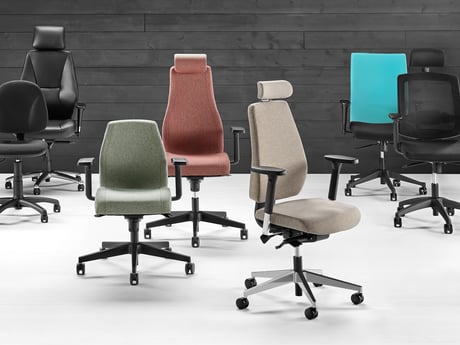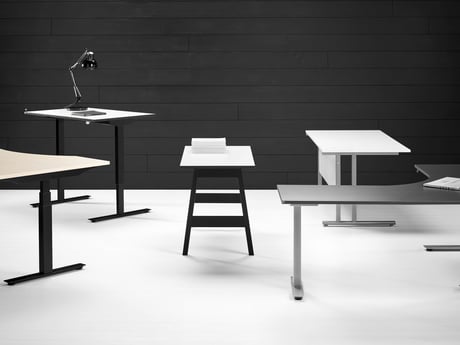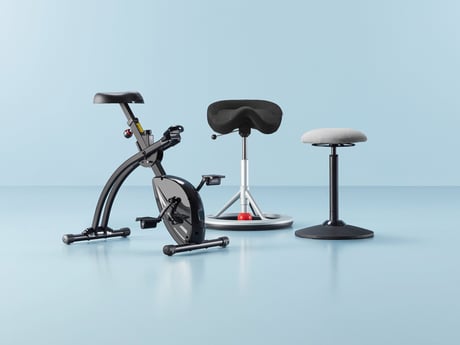
How has the desk changed over the past 40 years?

1980s
Remember this? In this typical picture from the 1980s, you can see poodle haircuts and shoulder pads so broad that people can hardly walk down the narrow office corridors. But how did the office space look back then? Well, people sat and worked, usually at a desk with four legs and a fixed set of drawers. Beside the desk, at a 90° angle, was a low table for the most important tool in the workplace: an electric typewriter.
Gradually, the typewriters were replaced by computers, first in the form of what were known as word processors. But as computers came to handle more and more applications, they grew in size too, making it very crowded on the desk! So, at the end of the decade, we introduced separate computer workstations where the keyboard and the screen were placed on different levels for better ergonomics.

1990s
In the mid 90s, the Internet took over as the most important tool in offices, which was fine because most office workers had already started working at a computer full time by that point. To counteract problems stemming from static work positions, we introduced the PC Total desk, a complete workstation designed to prevent strain injuries. However, work was still very sedentary for most people.
Since the popular cell office layout provided plenty of space, the large extendable desk combinations lived on. Sometimes they were made even bigger thanks to an added corner section for the computer. The expression "easy to reach" was coined for a U-shaped desk where the user could sit in the middle and have everything close at hand. Around the same time, laptops first appeared and became popular due to their convenient design.

2000s
Once the much-feared Millennium bug passed by unnoticed, a new millennium awaited, one that would bring with it several new office innovations. Perhaps the biggest news from the office world was the first appearance of a desk that would go on to become one of the most talked about pieces of office furniture (and one of the most popular products in our range): the height-adjustable desk. The design and technical solutions varied a great deal from desk to desk, but the key thing was that it offered people the chance to easily change their working position.
Another trend was that colleagues started sitting together again. Private offices and cubicles were resigned to the 90s and the open office became commonplace. Desks were placed in groups of two or four, sometimes in the middle of the room, and were divided only by desk screens that provided some privacy and additional soundproofing. Desktop design moved towards more natural colours and materials, giving a softer and more pleasant look. With respect to added extras, holes were added into desktops and cable trays were provided underneath to minimise cord clutter.

2010s
The vuvuzelas at the 2010 World Cup set the tone at the turn of the decade but were soon banned in many places as the loud sound was considered harmful. It wasn’t the only place that noise was addressed. Improving office acoustics would be a big challenge for many – a consequence of the shift to open plan offices. Another cause of workplace dissatisfaction and injuries that we addressed throughout the decade was static working positions. Since we already had a wide range of sit-stand desks that could be adjusted in height, we focused on ergonomic seating solutions as a complement to the ordinary office chair. While balance stools, Pilates balls, saddle chairs and desk bikes provided a different sitting position (a variation in itself), they also kept the body moving, which offered an effective way to improve wellbeing.
For those who only worked at a desk a few hours a day, we recommended a more simple, fixed-height desk combined with a good office chair that could be easily adjusted to their individual needs. Towards the end of the decade, we also introduced a smart sit-stand desk, which, with the help of technology, was able to keep track of daily activity and remind the user when it was time to change their working position. All to ensure that more people had a better and healthier workday.

2020s
The new decade had barely begun when a virus caused an unexpected reshuffling of workplaces all over the world. The need for creating a good ergonomic work environment at home grew like wildfire as a result of the pandemic. We met the need by introducing small and versatile mobile desks and by developing a new furniture range designed especially for the home office and small workspaces.
The current wide range enables you to buy a desk that is completely adapted to your personal needs and allows you to stay active at work. Considering how far we have come it would be easy to believe that we have reached the pinnacle. But we know that’s not true, development never takes a break, and we are prepared to adapt our desks to suit future shifts in technology as we have before. All in order to deliver desks that are in step with the demands of time and technology.
[Pictures taken from the AJ Products’ image archive]



